Plants can liven up any space, be it your home or office, and their presence is known to even increase productivity of humans. But, if your house doesn't have access to much sunlight, fret not, you can opt for plants that don't need sunlight. Now, no sunlight', refers to plants that require minimum or very less sunlight. These plants can survive for weeks without direct sunlight.
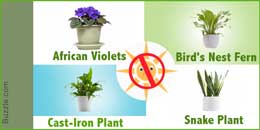
Indoor plants not only purify the surrounding air but also enhance the decor of your house. In fact, you will be amazed by the number of benefits that a houseplant can bring to your life. Research shows that keeping plants indoors can purify the air and get rid of harmful chemicals that are emitted by certain household products. Toxins like benzene, ammonia, and formaldehyde are absorbed and in turn replaced with oxygen.
Since most indoor plants are tropical plants, they thrive in low, indirect and bright lights. Normally, direct sunlight is about 32,000-100,000 lux, i.e. the unit of illuminance. 100 lux or less is considered low intensity or indirect lighting, and about 400 lux would be bright lighting. Anything above 1000 lux is considered high intensity lighting. So, plants preferring
low light should be kept in places which don't receive direct sunlight. For
indirect sunlight, plants should be placed at least 3 feet away from windows streaming direct sunlight. Plants thriving in
bright light can be placed next to a sunny window. It is always beneficial for plants to get some sunlight once in a while.
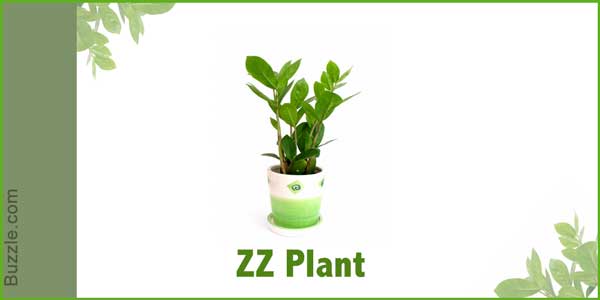
Zamioculcas zamiifolia, or the ZZ plant, as it is most commonly known, is native to East Africa. This tropical ornamental plant is preferred by homeowners mostly for its dark rich foliage and really easy maintenance requirements. It can grow to a height of about 3 feet and has glossy, dark green pinnate leaves. These plants cleanse the air and are excellent for your home or office.
Watering: Water only when the top soil dries. Never let the soil be soggy, as it rots the rhizomes.
Placement: Keep the plant in bright or low light. Direct sunlight tends to burn the leaves, turning them brown.
Temperatures: 65° F to 75° F. Temperatures below 60° F will kill the plant.
Fertilizers: Feed water-soluble fertilizer diluted in half, four times a year.
Care: Well-drained soil works best for these plants. Mix 1 part good potting mix and 1 part sand. You can use cactus mix as well. Keep away from direct sunlight and never over-water the plant. However, you can keep them under direct light for sometime, in the early morning. Never use leaf shiners on the leaves. Use a soft cloth to wipe off dust from leaves. Do remember that all parts of the plant are poisonous and should be kept away from children and pets.
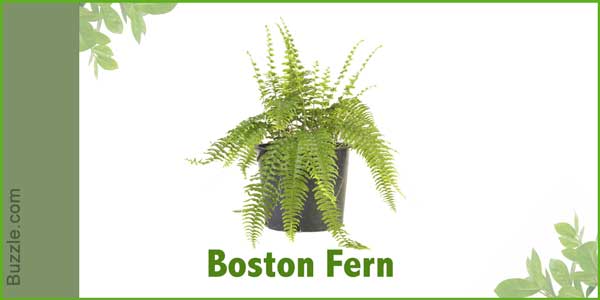
Boston ferns or Nephrolepis exaltata are the most common type of ferns. Native to the tropics, these graceful ferns are fast becoming favorites for elegant indoor décor. The fronds are usually light green with a feathery look. They are fast growers and can grow to a height of about 5 feet. Boston ferns are also known for their various air purifying benefits. In fact, they are the best plants to remove formaldehyde from indoors. The plant also releases water vapor in the air and restores moisture
Watering: Ferns are tropical plants and hence need lots of water. Water everyday and keep the soil damp. In winters, water when the soil feels dry.
Placement: Bright and indirect light is best suited for these ferns. Keep them near a window to get some natural light once in a while, for healthy growth.
Temperatures: 60° F to 75° F. However, they can tolerate cold temperatures of about 50° F too.
Fertilizers: Do not need too much of fertilizers but a water-soluble liquid fertilizer mixed at half strength will do during spring and summer. Do not feed during fall and winter.
Care: These plants like humidity and hence should be kept in warm conditions. If the fronds turn yellow or start fading, your fern needs more water. It is a good idea to mist the plant once in a while to keep it clean and to balance the humidity. It is also advisable to water the plants with distilled water, as chlorinated water might affect the growth of the plant. Remove any dead fronds and occasionally rotate the plant to keep the growth even. These plants are susceptible to mealy bugs and spider mites. Clean them with a wet cloth to get rid of the bugs.
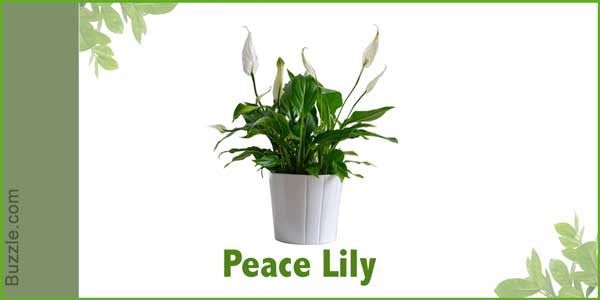
Peace lily or Spathiphyllum is native to the Americas and Southeast Asia. They have large glossy dark green leaves and white flowers. They are rather exotic looking and are closely related to the anthurium. They can grow to a height of 50 inches. The peace lily is known to reduce molds and also absorb atmospheric vapors like alcohol and acetone. Prolonged exposure to these chemicals can lead to various health problems.
Watering: Water once a week. The peace lily droops slightly when it needs watering. Don't let the soil become soggy or dry.
Placement: Thrives in low light. Cannot tolerate direct sunlight.
Temperatures: Grows best in warm temperatures from 65° F to 80° F. However, anything less than 55° F will kill the plant.
Fertilizers: Fertilize every spring and summer with a general houseplant fertilizer diluted to about ¼ of the recommended dilution rate. Mist the flowers and leaves regularly to remove any dust.
Care: Since cold temperatures can kill the plant, keep it away from drafts. Peace lilies are sensitive to chlorinated water. Using equal amounts of peat moss, sand and loam for the soil will ensure its healthy growth. They are also susceptible to aphids, spider mites, and mealy bugs. You can easily get rid of them by wiping them with a cloth dipped in water and insecticide. These plants are poisonous for pets.
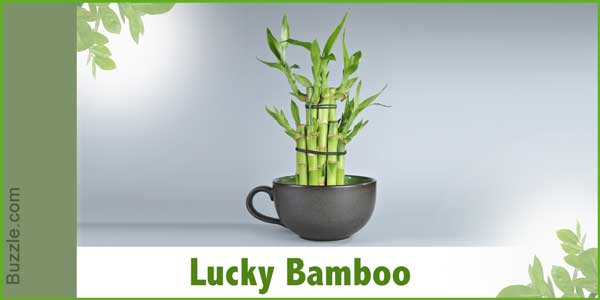
Lucky bamboo or Dracaena sanderiana is native to the African rainforests. Although the name suggests 'bamboo', they are not related to the bamboo at all, but are related to the lily family. This plant grows vertically and has slender stems with light green leaves. According to Feng Shui, this plant is said to bring luck to the people around it.
Watering: Although the lucky bamboo can grow in soil, it can also be grown in a simple vase filled with at least an inch of water and stones or pebbles for support. Surprisingly, soil is not essential for this plant to grow! Do remember that it is very sensitive to chlorine or any other chemicals present in water. Change water every week for healthy growth of this plant.
Placement: These plants prefer bright or low light. Do not expose to direct sunlight as it might burn the leaves.
Temperatures: 65° F to 80° F. Keep away from drafts and air conditioning.
Fertilizers: Fertilize the plant with a drop of weak liquid fertilizer every month.
Care: The most common problems with these plants are the leaves turning yellow or the roots turning black. Too much light or fertilizer can be a reason for the leaves turning yellow. Black roots indicate that the water is either dirty or the plant has been infected with bacteria. Always clean the plant with distilled water to avoid any problems.
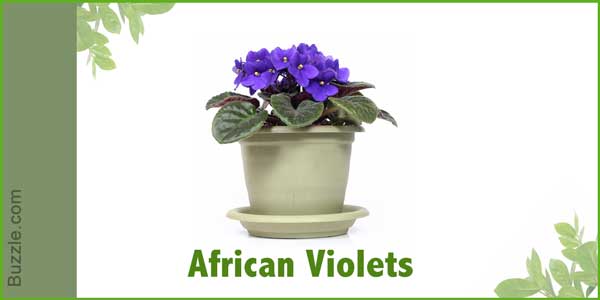
African violets or Saintpaulia are natives to Tanzania. The leaves are dark green to almost purplish color, round or oval. The flowers are usually violet but also exhibit purple, pale blue or white colors. It is a much-loved indoor plant because of its low height (15 cm.) which allows it to adapt to small spaces. Another reason why this plant should be in your house because it stimulates the release of endorphins and adrenaline that helps in relaxation and stress release.
Watering: Watering is best when the soil feels dry. Over-watering can kill the plant. Keep the soil moist not soggy.
Placement: Bright or indirect sunlight is best for these plants. Direct sunlight however, tends to discolor and curl the leaves.
Temperatures: 65° F to 70° F is suitable for healthy growth. Anything below 60° F or above 80° F might wither the leaves and flowers.
Fertilizers: Fertilize with any well-balanced water-soluble fertilizer (15-30-15) at the rate of ¼ teaspoon per gallon of water, in the growing seasons i.e. spring, summer and autumn.
Care: The African violets like humidity and thrive in 60-70% humidity. Remember to keep the soil well-drained. Always keep the soil moist however, keep the leaves dry at all times. If you notice any white, cotton clusters on the plant, it indicates infestation by mealy bugs. You can take care of them by rubbing them with a cotton swab dipped in alcohol. Trim off any withered leaves or flowers to maintain the proper growth of the plant.
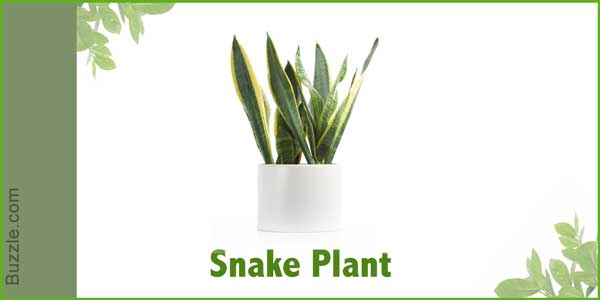
Sansevieria trifasciata, also known as mother-in-law's tongue or snake plant, is native to tropical West Africa. The snake plant has sword-like leaves that grow upright with gray or light green banding over a dark green base. They are tough succulents and can grow to a height of about 30-35 inches. This plant requires very little maintenance and is ideal for people who do not know much about plants and their care. These plants are also well-known for their air purifying qualities.
Watering: Water only when the soil is dry. Watering once a week is enough. During winters, water only once a month.
Placement: Anywhere from low to bright light suits these plants.
Temperatures: These plants prefer warm temperatures. 60° F to 80° F is perfect for these plants.
Fertilizers: Fertilize with a cactus fertilizer or a water-soluble fertilizer with half strength every 4 to 6 months. Do not fertilize in the fall and winter.
Care: Over-watering will kill the plant. It is advisable to use a good quality potting mix to keep the plant healthy. Do not let the leaves remain wet and use distilled or rainwater if possible. The tip of these plants are sharp, so keep them in a corner where you won't get nicked. Also, these plants are toxic and should be kept away from children and pets.
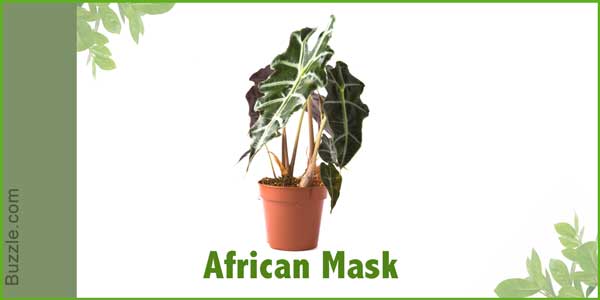
The Alocasia 'Polly' (Araceae), commonly known as the African mask, is a tropical plant, even though it is ideally grown indoors. These plants have heart-shaped, dark, glossy green leaves with silver veins. They can grow to a height of about 2 feet. What makes this ornamental plant distinctive, is the deep burgundy backs and pretty scalloped edges of the leaves.
Watering: Water the plant to keep the soil moist at all times. Use distilled or rainwater to maintain the plant's healthy growth.
Placement: Place the plant in bright or indirect light. Direct sunlight will wither the leaves.
Temperatures: 75° F to 85° F. These are humidity loving plants.
Fertilizers: Fertilize the plant every two weeks with a general plant or acid-rich fertilizer at half strength in the summers. Never fertilize the African mask in winters.
Care: Since the plant thrives in humidity, place the pot on a tray with pebbles and water. Plant them in organic-rich soil with proper drainage. Mist the leaves with soapy water to ensure dust-free leaves and any infestation of mealy bugs. Do remember that all parts of this plant are poisonous when ingested.
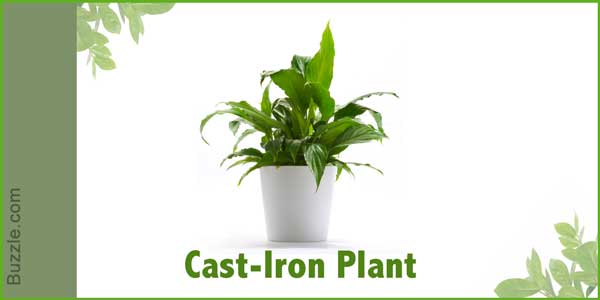
The cast iron plant goes by the scientific name of Aspidistra elatior. This plant is a slow grower but can adapt to any conditions. This plant is believed to have originated from Japan and can grow to a height of about 24 inches. They have coarse, long green leaves with small purple flowers. The plant gets its name from its ability to withstand any condition.
Watering: Although the cast-iron can survive without water for days, it is advisable to keep the soil moist for healthy growth.
Placement: The plant can survive in low light or indirect sunlight.
Temperatures: 50° F to 75° F.
Fertilizers: Use any balanced fertilizer diluted by half once a month. Refrain from feeding during the winters.
Care: Since these plants need very little water, avoid watering much in winters. Use regular soil with some sand for proper drainage. Do not let the leaves sit in water, as that might rot the leaves. These plants have good resistance to pests, however, they are susceptible to leaf spotting diseases. Clean the leaves once in a while to keep the dust away.
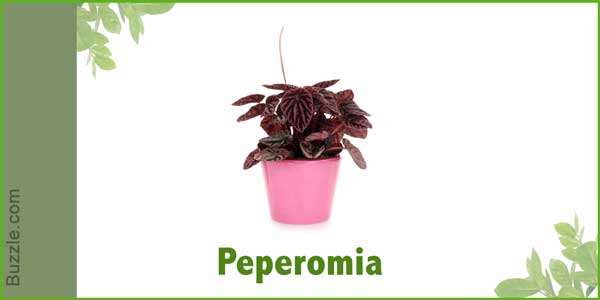
The peperomia has more than a thousand different species under it. A native to tropical America, these plants have oval or heart-shaped fleshy leaves with spiky flowers. They can grow to about one foot in height. These plants are known to remove formaldehyde and other toxins from the air.
Watering: Water only when the soil is dry.
Placement: The plants with green leaves prefer less light than the variegated ones. Bright light is ideal for these plants. Keep away from direct sunlight.
Temperatures: 55° F to 80° F.
Fertilizers: Use any diluted plant fertilizer at half strength once every two weeks.
Care: Never over-water the peperomia. In fact, refrain from watering in low temperatures. Well-drained soil is very important for these plants. Use sand, loam or bark for this. Avoid any moisture retaining material like peat moss. The peperomia is susceptible to bugs. If the plant is infected by mealy bugs, worms or fungus gnats, spray a good insecticide once a week. This will eliminate the infestation. Remove all infected parts of the plant.
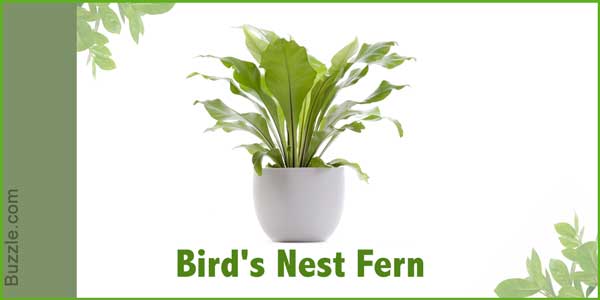
The bird's nest fern or Asplenium nidus looks nothing like the usual ferns. They have long, leathery green fronds. Native to the rainforests of Asia, Africa and Australia, these plants grow mostly on tree trunks. But they make excellent houseplants too. They can grow to a height of about 18 inches.
Watering: The bird's nest prefers moist soil. However, keeping the soil soggy will kill the plant.
Placement: Medium indirect light is ideal. Too much sunlight will burn the plant.
Temperatures: 60° F to 90° F.
Fertilizers: Use general fertilizer twice in spring and summer at half the strength recommended. Remember not to over-fertilize.
Care: Do not leave the soil soggy and never mist the leaves. Rich organic, loose soil is best. These plants do not like their soil wet. Humidity is very important for these plants. You can put the plant on a tray filled with water and pebbles. This makes it more susceptible to fungal diseases. If the bird's nest gets infected with mealy bugs, use a cotton swab dipped in alcohol to clean the infected area. Never spray insecticides directly on the leaves.
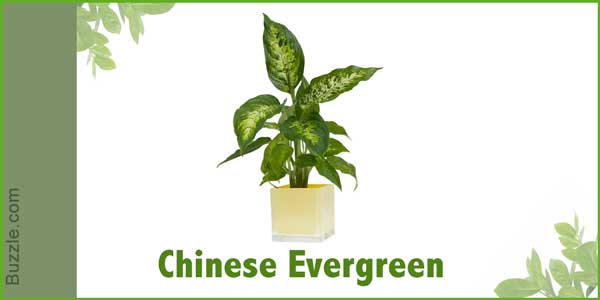
Chinese evergreens, or Aglaonema, are probably the most common and long-lasting indoor plants. These plants are a native to Southeast Asia and can be found in many varieties. The variegated ones are mostly preferred as ornamental plants. They have rather large pointed leaves with heavy marbling in white or cream, over a green base. The plant also produces small red berries. These plants are often kept indoors as they are known to purify the surrounding air.
Watering: Water the plant when the soil feels dry. Water just to wet the soil.
Placement: Since these are tropical plants, they prefer indirect light.
Temperatures: 65° F to 75° F.
Fertilizers: Feed every month with any liquid fertilizer diluted by half.
Care: Never mist the leaves with water. You can however clean away any dust or bugs by rubbing the leaves with a soft cloth. Do not let the soil become too dry or the leaves will turn yellow and start drooping. Trim off any dead or yellow leaves. Remember not to place your plant near drafts or this may leave ugly brown spots on the leaves. The sap and berries of this plant is poisonous, hence, it is advisable to keep them away from children and pets.Adding a few indoor plants in your 'not so sunny' house can instantly liven up the décor and your mood. After all, it is well-known that plants soothe the brain and reduce stress. These plants can be easily grown by anyone as they are very easy to maintain and hardly need any sunlight. So, don't worry if you have a brown thumb, bring home a plant and feel the positive changes for yourself.






 Indoor plants not only purify the surrounding air but also enhance the decor of your house. In fact, you will be amazed by the number of benefits that a houseplant can bring to your life. Research shows that keeping plants indoors can purify the air and get rid of harmful chemicals that are emitted by certain household products. Toxins like benzene, ammonia, and formaldehyde are absorbed and in turn replaced with oxygen.
Indoor plants not only purify the surrounding air but also enhance the decor of your house. In fact, you will be amazed by the number of benefits that a houseplant can bring to your life. Research shows that keeping plants indoors can purify the air and get rid of harmful chemicals that are emitted by certain household products. Toxins like benzene, ammonia, and formaldehyde are absorbed and in turn replaced with oxygen.  Zamioculcas zamiifolia, or the ZZ plant, as it is most commonly known, is native to East Africa. This tropical ornamental plant is preferred by homeowners mostly for its dark rich foliage and really easy maintenance requirements. It can grow to a height of about 3 feet and has glossy, dark green pinnate leaves. These plants cleanse the air and are excellent for your home or office.Watering: Water only when the top soil dries. Never let the soil be soggy, as it rots the rhizomes.
Zamioculcas zamiifolia, or the ZZ plant, as it is most commonly known, is native to East Africa. This tropical ornamental plant is preferred by homeowners mostly for its dark rich foliage and really easy maintenance requirements. It can grow to a height of about 3 feet and has glossy, dark green pinnate leaves. These plants cleanse the air and are excellent for your home or office.Watering: Water only when the top soil dries. Never let the soil be soggy, as it rots the rhizomes.  Boston ferns or Nephrolepis exaltata are the most common type of ferns. Native to the tropics, these graceful ferns are fast becoming favorites for elegant indoor décor. The fronds are usually light green with a feathery look. They are fast growers and can grow to a height of about 5 feet. Boston ferns are also known for their various air purifying benefits. In fact, they are the best plants to remove formaldehyde from indoors. The plant also releases water vapor in the air and restores moistureWatering: Ferns are tropical plants and hence need lots of water. Water everyday and keep the soil damp. In winters, water when the soil feels dry.
Boston ferns or Nephrolepis exaltata are the most common type of ferns. Native to the tropics, these graceful ferns are fast becoming favorites for elegant indoor décor. The fronds are usually light green with a feathery look. They are fast growers and can grow to a height of about 5 feet. Boston ferns are also known for their various air purifying benefits. In fact, they are the best plants to remove formaldehyde from indoors. The plant also releases water vapor in the air and restores moistureWatering: Ferns are tropical plants and hence need lots of water. Water everyday and keep the soil damp. In winters, water when the soil feels dry. Peace lily or Spathiphyllum is native to the Americas and Southeast Asia. They have large glossy dark green leaves and white flowers. They are rather exotic looking and are closely related to the anthurium. They can grow to a height of 50 inches. The peace lily is known to reduce molds and also absorb atmospheric vapors like alcohol and acetone. Prolonged exposure to these chemicals can lead to various health problems.Watering: Water once a week. The peace lily droops slightly when it needs watering. Don't let the soil become soggy or dry.
Peace lily or Spathiphyllum is native to the Americas and Southeast Asia. They have large glossy dark green leaves and white flowers. They are rather exotic looking and are closely related to the anthurium. They can grow to a height of 50 inches. The peace lily is known to reduce molds and also absorb atmospheric vapors like alcohol and acetone. Prolonged exposure to these chemicals can lead to various health problems.Watering: Water once a week. The peace lily droops slightly when it needs watering. Don't let the soil become soggy or dry. Lucky bamboo or Dracaena sanderiana is native to the African rainforests. Although the name suggests 'bamboo', they are not related to the bamboo at all, but are related to the lily family. This plant grows vertically and has slender stems with light green leaves. According to Feng Shui, this plant is said to bring luck to the people around it.Watering: Although the lucky bamboo can grow in soil, it can also be grown in a simple vase filled with at least an inch of water and stones or pebbles for support. Surprisingly, soil is not essential for this plant to grow! Do remember that it is very sensitive to chlorine or any other chemicals present in water. Change water every week for healthy growth of this plant.
Lucky bamboo or Dracaena sanderiana is native to the African rainforests. Although the name suggests 'bamboo', they are not related to the bamboo at all, but are related to the lily family. This plant grows vertically and has slender stems with light green leaves. According to Feng Shui, this plant is said to bring luck to the people around it.Watering: Although the lucky bamboo can grow in soil, it can also be grown in a simple vase filled with at least an inch of water and stones or pebbles for support. Surprisingly, soil is not essential for this plant to grow! Do remember that it is very sensitive to chlorine or any other chemicals present in water. Change water every week for healthy growth of this plant. African violets or Saintpaulia are natives to Tanzania. The leaves are dark green to almost purplish color, round or oval. The flowers are usually violet but also exhibit purple, pale blue or white colors. It is a much-loved indoor plant because of its low height (15 cm.) which allows it to adapt to small spaces. Another reason why this plant should be in your house because it stimulates the release of endorphins and adrenaline that helps in relaxation and stress release.Watering: Watering is best when the soil feels dry. Over-watering can kill the plant. Keep the soil moist not soggy.
African violets or Saintpaulia are natives to Tanzania. The leaves are dark green to almost purplish color, round or oval. The flowers are usually violet but also exhibit purple, pale blue or white colors. It is a much-loved indoor plant because of its low height (15 cm.) which allows it to adapt to small spaces. Another reason why this plant should be in your house because it stimulates the release of endorphins and adrenaline that helps in relaxation and stress release.Watering: Watering is best when the soil feels dry. Over-watering can kill the plant. Keep the soil moist not soggy. Sansevieria trifasciata, also known as mother-in-law's tongue or snake plant, is native to tropical West Africa. The snake plant has sword-like leaves that grow upright with gray or light green banding over a dark green base. They are tough succulents and can grow to a height of about 30-35 inches. This plant requires very little maintenance and is ideal for people who do not know much about plants and their care. These plants are also well-known for their air purifying qualities.Watering: Water only when the soil is dry. Watering once a week is enough. During winters, water only once a month.
Sansevieria trifasciata, also known as mother-in-law's tongue or snake plant, is native to tropical West Africa. The snake plant has sword-like leaves that grow upright with gray or light green banding over a dark green base. They are tough succulents and can grow to a height of about 30-35 inches. This plant requires very little maintenance and is ideal for people who do not know much about plants and their care. These plants are also well-known for their air purifying qualities.Watering: Water only when the soil is dry. Watering once a week is enough. During winters, water only once a month. The Alocasia 'Polly' (Araceae), commonly known as the African mask, is a tropical plant, even though it is ideally grown indoors. These plants have heart-shaped, dark, glossy green leaves with silver veins. They can grow to a height of about 2 feet. What makes this ornamental plant distinctive, is the deep burgundy backs and pretty scalloped edges of the leaves.Watering: Water the plant to keep the soil moist at all times. Use distilled or rainwater to maintain the plant's healthy growth.
The Alocasia 'Polly' (Araceae), commonly known as the African mask, is a tropical plant, even though it is ideally grown indoors. These plants have heart-shaped, dark, glossy green leaves with silver veins. They can grow to a height of about 2 feet. What makes this ornamental plant distinctive, is the deep burgundy backs and pretty scalloped edges of the leaves.Watering: Water the plant to keep the soil moist at all times. Use distilled or rainwater to maintain the plant's healthy growth. The cast iron plant goes by the scientific name of Aspidistra elatior. This plant is a slow grower but can adapt to any conditions. This plant is believed to have originated from Japan and can grow to a height of about 24 inches. They have coarse, long green leaves with small purple flowers. The plant gets its name from its ability to withstand any condition.Watering: Although the cast-iron can survive without water for days, it is advisable to keep the soil moist for healthy growth.
The cast iron plant goes by the scientific name of Aspidistra elatior. This plant is a slow grower but can adapt to any conditions. This plant is believed to have originated from Japan and can grow to a height of about 24 inches. They have coarse, long green leaves with small purple flowers. The plant gets its name from its ability to withstand any condition.Watering: Although the cast-iron can survive without water for days, it is advisable to keep the soil moist for healthy growth. The peperomia has more than a thousand different species under it. A native to tropical America, these plants have oval or heart-shaped fleshy leaves with spiky flowers. They can grow to about one foot in height. These plants are known to remove formaldehyde and other toxins from the air.Watering: Water only when the soil is dry.
The peperomia has more than a thousand different species under it. A native to tropical America, these plants have oval or heart-shaped fleshy leaves with spiky flowers. They can grow to about one foot in height. These plants are known to remove formaldehyde and other toxins from the air.Watering: Water only when the soil is dry.  The bird's nest fern or Asplenium nidus looks nothing like the usual ferns. They have long, leathery green fronds. Native to the rainforests of Asia, Africa and Australia, these plants grow mostly on tree trunks. But they make excellent houseplants too. They can grow to a height of about 18 inches.Watering: The bird's nest prefers moist soil. However, keeping the soil soggy will kill the plant.
The bird's nest fern or Asplenium nidus looks nothing like the usual ferns. They have long, leathery green fronds. Native to the rainforests of Asia, Africa and Australia, these plants grow mostly on tree trunks. But they make excellent houseplants too. They can grow to a height of about 18 inches.Watering: The bird's nest prefers moist soil. However, keeping the soil soggy will kill the plant. Chinese evergreens, or Aglaonema, are probably the most common and long-lasting indoor plants. These plants are a native to Southeast Asia and can be found in many varieties. The variegated ones are mostly preferred as ornamental plants. They have rather large pointed leaves with heavy marbling in white or cream, over a green base. The plant also produces small red berries. These plants are often kept indoors as they are known to purify the surrounding air.Watering: Water the plant when the soil feels dry. Water just to wet the soil.
Chinese evergreens, or Aglaonema, are probably the most common and long-lasting indoor plants. These plants are a native to Southeast Asia and can be found in many varieties. The variegated ones are mostly preferred as ornamental plants. They have rather large pointed leaves with heavy marbling in white or cream, over a green base. The plant also produces small red berries. These plants are often kept indoors as they are known to purify the surrounding air.Watering: Water the plant when the soil feels dry. Water just to wet the soil.